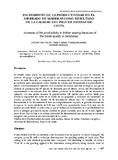Incremento de la productividad en el aserrado de madera como resultado de la calidad del filo de sierras de cinta

Visualizar/
Data
2015Palabras Clave
Productividad, Aserrado de la madera, Sierras de cintas, Consumo energético, Velocidad de alimentación, Espesor de virutaProductivity, Timber sawing, Band saws, Energy consumption, Speed of supply, Chip thickness
Metadatos
Mostrar registro completoResumo
Se estudió cómo puede ser incrementada la productividad en el proceso de aserrado de
maderas del grupo energético II, al aplicar una técnica que mejora la calidad del afilado de sierras de cinta. Para ello, se compararon dos herramientas de corte con idénticas magnitudes geométricas, pero atribuyendo como variable de estudio una Herramienta A representando al afilado convencionalmente aplicado en la industria del aserrío nacional al emplear una piedra abrasiva de granulometría 60 (piedra de desbaste) para el afilado, versus una Herramienta B representando a un acabado final del afilado producto de la utilización de un desbastador equipado con una piedra abrasiva de granulometría 120 (piedra para acabado final) para reducir la rugosidad del metal en el fondo de las gargantas y disminuir las cantidades de rebabas presentes en los dientes de la herramienta afilada bajo las condiciones de la Herramienta A. La Herramienta B tuvo un comportamiento superior, al permitir incrementar el espesor de viruta calculado de 0,58 mm a 0,74 mm, permitiendo tomar 0,16 mm más de madera por cada diente en cada corte, lo que se traduce en incrementos de la productividad del proceso al lograr producir la misma cantidad de piezas aserradas pero un 28 % más rápido al pasar de los 12,5 m/min a 16 m/min (velocidad de alimentación) sin incrementar el consumo energético del proceso ni afectar la rectitud de los cortes.
Información Adicional
| Otros Títulos | Increase of the productivity in timber sawing because of the blade quality in bandsaws Trejo F., Jhonattan J. |
| Correo Electrónico | tjhonattan@ula.ve ninin@ula.ve frosso@cantv.net |
| ISSN | 0556-6606 |
| Resumen en otro Idioma | It was studied how the productivity could be increased in the process of wood sawing for the energetic group II, with a technique that improves the grinding quality of band saws. Two cutting tools with identical geometry were compared, but attributing as variable of study a “Tool A” as the grinding applied in the venezuelan sawing industry using abrasive stone of granulometry 60 (stone of refines), versus a “Tool B” representing a final finish of the product through the utilization of a equipped chisel with an abrasive stone of granulometry 120 (stone by the final finish) to reduce the metal ruggedness down the throats decreasing the amount of burrs on the teeth edges of the tool under the “Tool A” conditions. The “Tool B” had a superior behavior, allowing to increase the chip thickness calculated from 0,58 mm to 0,74 mm, it means that it allowed to take more 0,16 mm of wood for every tooth in all cuts; this implies increases of the productivity of the process, producing the same quantity of pieces of sawn timber but 28 % faster from the 12,5 m/min to 16 m/min (speed of supply) without increasing the energetic consumption of the process and it doesn´t affecting the straightness of the cuts. |
| Colación | 47-61 |
| Periodicidad | Semestral |
| País | Venezuela |
| Institución | Universidad de Los Andes |
| Publicación Electrónica | Revista Forestal Venezolana |
| Sección | Revista Forestal Venezolana: Artículo |





